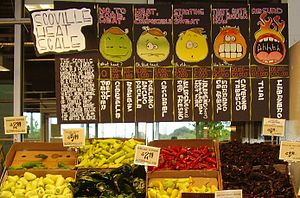Pungency

Pungency(/ˈpʌndʒənsi/) refers to the taste of food commonly referred to asspiciness,hotnessorheat,[1][2][3]found in foods such aschili peppers.Highly pungent tastes may be experienced as unpleasant. The termpiquancy(/ˈpiːkənsi/) is sometimes applied to foods with a lower degree of pungency[4]that are "agreeably stimulating to the palate". Examples of piquant food includemustardandcurry.The primary substances responsible for pungent taste arecapsaicin,piperine(in peppers) andallyl isothiocyanate(inradish,mustardandwasabi).
Terminology
[edit]In colloquial speech, the term "pungency" can refer to any strong, sharpsmellorflavor.[5][6]However, in scientific speech, it refers specifically to the "hot" or "spicy" quality ofchili peppers.It is the preferred term by scientists as it eliminates the ambiguity arising from use of "hot", which can also refer to temperature, and "spicy", which can also refer tospices.[1][2][7]
For instance, apumpkin piecan be both hot (out of the oven) and spicy (due to the common inclusion of spices such ascinnamon,nutmeg,allspice,mace,andcloves), but it is notpungent.Conversely, purecapsaicinis pungent, yet it is not naturally accompanied by a hot temperature or spices.
As the Oxford, Collins, and Merriam-Webster dictionaries explain, "piquancy" can refer to mild pungency,[6]that is, flavors and spices that are much less strong thanchilli peppers,including, for example, the strong flavor of some tomatoes. In other words, pungency always refers to a very strong taste whereas piquancy refers to any spices and foods that are "agreeably stimulating to the palate", in other words to food that is spicy in the general sense of "well-spiced".
Mildly pungent or sour foods may be referred to as tangy.
Uses
[edit]Pungency is often quantified in scales that range from mild to hot. TheScoville scalemeasures the pungency ofchili peppers,as defined by the amount ofcapsaicinthey contain.

Pungency is not considered a taste in the technical sense because it is carried to the brain by a different set of nerves. While taste nerves are activated when consuming foods like chili peppers, the sensation commonly interpreted as "hot" results from the stimulation ofsomatosensoryfibers in the mouth. Many parts of the body with exposed membranes that lack taste receptors (such as the nasal cavity, genitals, or a wound) produce a similar sensation of heat when exposed to pungent agents.
The pungent sensation provided by chili peppers,black pepperand other spices likegingerandhorseradishplays an important role in a diverse range of cuisines across the world.
Pungent substances, likecapsaicin,are used intopicalanalgesicsandpepper sprays.[8][9]
Mechanism
[edit]Pungency is sensed viachemesthesis,the sensitivity of the skin and mucous membranes to chemical substances. Substances such aspiperine,capsaicin, andthiosulfinatescan cause a burning or tingling sensation by inducing atrigeminal nervestimulationtogether with normal taste reception. The pungent feeling caused byallyl isothiocyanate,capsaicin, piperine, andallicinis caused by activation of the heat thermo- and chemosensitiveTRP ion channelsincludingTRPV1andTRPA1nociceptors.The pungency of chilies may be anadaptive responseto microbial pathogens.[1]
Favoring by humans
[edit]Capsaicin evolved in peppers to deter particularly seed-eating rodents that destroy seeds by grinding, thwarting theirgermination,while at the same allowing birds to eat them anddispersethrough defecation[10](in birds, pepper seeds are not destroyed by consumption and digestion). It was found that birds do not feel pungency due to lack ofTRP channels,but mammals, including rodents and humans, do have them.[10]
Unlike most other mammals, however, many humans favor pungent and spicy food (including traditionally spicy regional cuisines). Multiple reasons for that have been proposed. The thrill-seeking theory suggests that some people are attracted to spicy taste due to intense sensations or thrills.[11]According to the antimicrobial theory, general spices have been added to foods in hot climates due toantimicrobialproperties of related substances.[11]The only other mammal known to consume pungent food isnorthern treeshrew(Tupaia belangeri).[12]
See also
[edit]References
[edit]- ^abcTewksbury, J. J.; Reagan, K. M.; Machnicki, N. J.; Carlo, T. A.; Haak, D. C.; Penaloza, A. L. C.; Levey, D. J. (2008)."Evolutionary ecology of pungency in wild chilies".Proceedings of the National Academy of Sciences.105(33): 11808–11811.Bibcode:2008PNAS..10511808T.doi:10.1073/pnas.0802691105.PMC2575311.PMID18695236.
- ^ab"Chile Terminology"(PDF).Chile Pepper Institute, New Mexico State University. 2006. Archived fromthe original(PDF)on October 16, 2012.RetrievedSeptember 14,2012.
- ^"Chile Heat"(PDF).Chile Pepper Institute, New Mexico State University. 2006. Archived fromthe original(PDF)on October 16, 2012.RetrievedSeptember 14,2012.
- ^"Merriam-Webster Dictionary:" Piquant "".Merriam-webster.Archivedfrom the original on November 15, 2022.RetrievedFebruary 7,2014.
- ^"Pungency".Collins English Dictionary. February 3, 2014.Archivedfrom the original on February 21, 2014.RetrievedFebruary 7,2014.
- ^ab"Merriam-Webster Dictionary:" Pungent "".Merriam-webster.Archivedfrom the original on January 22, 2014.RetrievedFebruary 7,2014.
- ^Haak, D. C.; McGinnis, L. A.; Levey, D. J.; Tewksbury, J. J. (2011)."Why are not all chilies hot? A trade-off limits pungency".Proceedings of the Royal Society B: Biological Sciences.279(1735): 2012–2017.doi:10.1098/rspb.2011.2091.PMC3311884.PMID22189403.
- ^"Capsaicin".PubChem, US National Library of Medicine. 29 April 2023.Archivedfrom the original on 12 June 2018.Retrieved2 May2023.
- ^Anand, P.; Bley, K. (October 2011)."Topical capsaicin for pain management: therapeutic potential and mechanisms of action of the new high-concentration capsaicin 8% patch".British Journal of Anaesthesia.107(4): 490–502.doi:10.1093/bja/aer260.ISSN0007-0912.PMC3169333.PMID21852280.
- ^abJoshua J. Tewksbury, Gary P. Nabhan (26 July 2001)."Directed deterrence by capsaicin in chillies".Nature.412(6845): 403–404.doi:10.1038/35086653.PMID11473305.S2CID4389051.Retrieved31 January2024.
- ^abEmily Siebert, Soo-Yeun Lee, Melissa Pflugh Prescott (14 Dec 2022)."Chili pepper preference development and its impact on dietary intake: A narrative review".Frontiers in Nutrition.9.doi:10.3389/fnut.2022.1039207.PMC9795841.PMID36590220.
{{cite journal}}:CS1 maint: multiple names: authors list (link) - ^Various authors (17 July 2018)."Molecular mechanism of the tree shrew's insensitivity to spiciness".PLOS Biology.Retrieved31 January2024.
